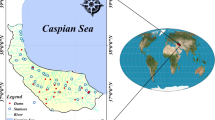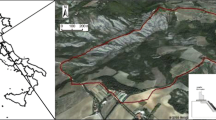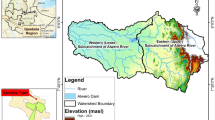Abstract
This study examines potential changes in the summer rainy season of a watershed, using a cumulative rainy deficit curve to define the onset and demise of the rainy season. Historical daily rainfall data from 41 gauge stations within the Xiang River Basin in 1960–2017 were analyzed. Results indicate that the climatology of the onset date is Julian day 72 and the climatology of the demise date is Julian day 236. There is, however, a difference between the two segments, e.g., 1960–1989 and 1990–2017. The median rainy season duration in 1990–2017 is 138 days. This is larger than that of 1960–1989, which is 120 days. There is a statistically significant correlation between the onset date of the rainy season and the duration of the rainy season. Daily soil moisture estimates were derived from satellite remote sensing data. The averaged soil moisture during the rainy season is much higher than that of the non-rainy season. To examine the difference in quick flow between rainy and non-rainy season, baseflow separation was applied to daily streamflow time series. Result reveals the median of weekly quick flow in rainy season is 1316 cms, which is 5.7 times that of the weekly quick flow in non-rainy season. Different mechanisms that drive spring and summer rainfall, as well as potential use of the results in water management, are discussed.








Similar content being viewed by others
Availability of Data and Materials
Data and material are available upon request to the corresponding author.
References
Ayantobo O, Li Y, Song SB, Yao N (2018) Spatial comparability of drought characteristics and related return periods in mainland China over 1961–2013. J Hydrol 550:549–567. https://doi.org/10.1016/j.jhydrol.2017.05.019
Chiang JCH, Swenson LM, Kong W (2017) Role of seasonal transitions and the westerlies in the interannual variability of the East Asian summer monsoon precipitation. Geophys Res Lett 44:3788–3795. https://doi.org/10.1002/2017GL072739
Chen JP, Wen ZP, Wu RG, Wang X, He C, Chen ZS (2017) An interdecadal change in the intensity of interannual variability in summer rainfall over southern China around early 1990s. Clim Dyn 48(1–2):191–207. https://doi.org/10.1007/s00382-016-3069-8
Ding YH (1992) Summer monsoon precipitations in China. J Meteorol Soc Jpn 70:373–396. https://doi.org/10.2151/jmsj1965.70.1B_373
Fan K, Xu ZQ, Tian BQ (2014) Has the intensity of the interannual variability in summer rainfall over South China remarkably increased? Meteorol Atmos Phys 124(1–2):23–32. https://doi.org/10.1007/s00703-013-0301-5
Feng J, Li JP (2011) Influence of El Niño Modoki on spring rainfall over south China. J Geophys Res 116(D13):D13102. https://doi.org/10.1029/2010JD015160
Fuka DR, Walter MT, Archibald JA, Steenhubis TS, Easton ZM (2018) “EcohydRology” R package: A Community Modeling Foundation for Eco-Hydrology 0.4.12.1
Ge F, Zhi X, Babar ZA, Tang WW, Chen P (2017) Interannual variability of summer monsoon precipitation over the Indochina Peninsula in association with ENSO. Theoret Appl Climatol 128(3–4):523–531. https://doi.org/10.1007/s00704-015-1729-y
Gorelick N, Hancher M, Dixon M, Ilyushchenko S, Thau D, Moore R (2017) Google earth engine: Planetary-scale geospatial analysis for everyone. Remote Sens Environ 18–27. https://doi.org/10.1016/j.rse.2017.06.031
Gu XH, Zhang Q, Li JF, Singh VP, Sun P (2019a) Impact of urbanization on nonstationarity of annual and seasonal precipitation extremes in China. J Hydrol 575:638–655. https://doi.org/10.1016/j.jhydrol.2019.05.070
Gu XH, Zhang Q, Singh VP, Song CQ, Sun P, Li JF (2019b) Potential contributions of climate change and urbanization to precipitation trends across China at national, regional and local scales. Int J Climatol 39(6):2998–3012. https://doi.org/10.1002/joc.5997
Guo RF, Zhu YQ, Liu YB (2020) A Comparison Study of Precipitation in the Poyang and the Dongting Lake Basins from 1960–2015. Sci Rep 10(1):3381. https://doi.org/10.1038/s41598-020-60243-8
Hamed HK (2008) Trend detection in hydrologic data: The Mann-Kendall trend test under the scaling hypothesis. J Hydrol 348(3–4):350–363. https://doi.org/10.1016/j.jhydrol.2007.11.009
Hardiman SC, Dunstone DJ, Scaife AA, Bett PE, Li CF, Lu B, Ren HL, Smith DM, Stephan CC (2018) The asymmetric response of Yangtze River basin summer rainfall to El Niño/La Niña. Environ Res Lett 13(2):024015. https://doi.org/10.1088/1748-9326/aaa172/meta
Huang SF, Li JG, Xu M (2012) Water surface variations monitoring and flood hazard analysis in Dongting Lake area using long-term Terra/MODIS data time series. Nat Hazards 62(1):93–100. https://doi.org/10.1007/s11069-011-9921-6
Jin DC, Guan ZY, Cai JX, Tang WY (2015) Interannual variations of regional summer precipitation in Mainland China and their possible relationships with different teleconnections in the past five decades. J Meteorol Soc Jpn 93(2):265–283. https://doi.org/10.2151/jmsj.2015-015
Kendall MG (1975) Rank correlation methods. Oxford University Press, New York, NY
Li BF, Chen Y, Chen ZS, Xiong HG, Lian LS (2016a) Why does precipitation in northwest China show a significant increasing trend from 1960 to 2010? Atmos Res 167(1):275–284. https://doi.org/10.1016/j.atmosres.2015.08.017
Li CF, Scaife AA, Lu R, Arribas A, Brookshaw A, Comer RE, Li JL, MacLachlan C, Wu P (2016b) Skillful seasonal prediction of Yangtze river valley summer rainfall. Environ Res Lett 11:094002. https://doi.org/10.1088/1748-9326/11/9/094002
Li H, He SP, Fan K, Wang HJ (2018) Relationship between the onset date of the Meiyu and the South Asian anticyclone in April and the related mechanisms. Clim Dyn 52(1):209–226. https://doi.org/10.1007/s00382-018-4131-5
Li XM, Jiang FQ, Li L, Wang GG (2011) Spatial and temporal variability of precipitation concentration index, concentration degree and concentration period in Xinjiang, China. Int J Climatol 31:1679–1693. https://doi.org/10.1002/joc.2181
Li YF, Guo Y, Yu G (2013) An analysis of extreme flood events during the past 400 years at Taihu Lake, China. J Hydrol 500:217–225. https://doi.org/10.1016/j.jhydrol.2013.02.028
Long Y, Lv Q, Wen X et al (2023) Bayesian logistic regression in providing categorical streamflow forecasts using precipitation output from climate models. Stoch Environ Res Risk Assess 37:639–650. https://doi.org/10.1007/s00477-022-02295-y
Lu E, Ding Y, Zhou B, Zou XK, Chen XY, Cai WY, Zhang Q, Chen HS (2016) Is the interannual variability of summer rainfall in China dominated by precipitation frequency or intensity? An analysis of relative importance. Clim Dyn 47(1–2):67–77. https://doi.org/10.1007/s00382-015-2822-8
Lu E, Luo YL, Zhang RH, Wu QX, Liu LP (2011) Regional atmospheric anomalies responsible for the 2009–2010 severe drought in China. J Geophys Res 116(D21):D21114. https://doi.org/10.1029/2011JD015706
Lu E, Zeng Y, Luo Y, Ding Y, Zhao W, Liu S, Gong L, Jiang Y, Jiang Z, Chen H (2014) Changes of summer precipitation in China: The dominance of frequency and intensity and linkage with changes in moisture and air temperature. J Geophys Res Atmos 119:12575–12587. https://doi.org/10.1002/2014JD022456
Lu RY, Oh JH, Kim BJ, Baek HJ, Huang RH (2001) Associations with the interannual variations of onset and withdrawal of the Changma. Adv Atmos Sci 18(6):1066–1080. https://doi.org/10.1007/s00376-001-0023-3
Luo M, Leung Y, Graf H-F, Herzog M, Zhang W (2016) Interannual variability of the onset of the South China Sea summer monsoon. Int J Climatol 36(2):550–562. https://doi.org/10.1002/joc.4364
Lyne VD, Hollick M (1979) Stochastic time-variable rainfall-runoff modeling. Hydrology and Water Resources Symposium, Perth, Institution of Engineers, Australia
Mann HB (1945) Nonparametric tests against trend. Econometrica 13:245–259. https://doi.org/10.2307/1907187
Misra V, Bhardwaj A, Mishra A (2018) Characterizing the rainy season of Peninsular Florida. Clim Dyn 51(5):2157–2167. https://doi.org/10.1007/s00382-017-4005-2
Misra V, DiNapoli S (2013) Understanding wet season variations over Florida. Clim Dyn 40:1361–1372
Song L, Deng Z, Dong A (2003) Hot topics of global change—drought (in Chinese). China Meteorological Press, 162 pp
Stephan CC, Klingaman NP, Vidale PL, Turner AG, Demory M, Guo L (2018) A comprehensive analysis of coherent rainfall patterns in China and potential drivers. Part i: Interannual variability. Clim Dyn 50:4405–4424. https://doi.org/10.1007/s00382-017-3882-8
Wang H, Asefa T, Erkyihun S (2021) Interannual variabilities of the summer and winter extreme daily precipitation in the Southeastern United States. J Hydrol. https://doi.org/10.1016/j.jhydrol.2021.127013
Wang L, Chen W, Zhou W, Huang G (2015) Teleconnected influence of tropical Northwest Pacific sea surface temperature on interannual variability of autumn precipitation in Southwest China. Clim Dyn 45(9–10):2527–2539. https://doi.org/10.1007/s00382-015-2490-8
Wang YF, Wang B, Oh JH (2001) Impact of the preceding El Niño on the East Asian summer atmosphere circulation. J Meteorol Soc Jpn 79:575–588. https://doi.org/10.2151/jmsj.79.575
Wang ZG, Luo YZ, Liu CM, Xia J, Zhang MH (2011) Spatial and temporal variations of precipitation in Haihe River Basin, China: six decades of measurements. Hydrol Process 25(18):2916–2923. https://doi.org/10.1002/hyp.8055
Wei L, Hu KH, Hu Xd (2018) Rainfall occurrence and its relation to flood damage in China from 2000 to 2015. J Mt Sci 15(11):2492–2504. https://doi.org/10.1007/s11629-018-4931-4
Wu Q (2020) geemap: A Python package for interactive mapping with Google Earth Engine. J Open Sour Softw 5(51):2305. https://doi.org/10.21105/joss.02305
Wu YJ, Wu S-Y, Wen JH, Xu M, Tan JG (2016) Changing characteristics of precipitation in China during 1960–2012. Int J Climatol 36(3):1387–1402. https://doi.org/10.1002/joc.4432
Xu K, Zhu CW, Wang WQ (2016) The cooperative impacts of the El Niño-Southern Oscillation and the Indian Ocean Dipole on the interannual variability of autumn rainfall in China. Int J Climatol 36(4):1987–1999. https://doi.org/10.1002/joc.4475
Yang P, Xia J, Zhang Y, Hong S (2017) Temporal and spatial variations of precipitation in Northwest China during 1960–2013. Atmos Res 183:283–295. https://doi.org/10.1016/j.atmosres.2016.09.014
Yao N, Li Y, Lei TJ, Peng LL (2018) Drought evolution, severity and trends in mainland China over 1961–2013. Sci Total Environ 616–617:73–89. https://doi.org/10.1016/j.scitotenv.2017.10.327
Ye J-S (2014) Trend and variability of China’s summer precipitation during 1955–2008. Int J Climatol 34(3):559–566. https://doi.org/10.1002/joc.3705
Yin J, Yu DP, Yin ZN, Liu M, He Q (2016) Evaluating the impact and risk of pluvial flash flood on intra-urban road network: A case study in the city center of Shanghai, China. J Hydrol 537:138–145. https://doi.org/10.1016/j.jhydrol.2016.03.037
Ying K, Zhao TB, Quan XW, Frederiksen C (2015) Interannual variability of autumn to spring seasonal precipitation in eastern China. Clim Dyn 45(1–2):253–271. https://doi.org/10.1007/s00382-014-2411-2
Zhang SL, Tao SY, Zhang QY et al (2001) (1998) Meteorological and hydrological characteristics of severe flooding in China during the summer of 1998. Quart J Appl Meteor Sci 12(4):442–457
Zhang Q, Xu CY, Jiang T, Wu Y (2007) Possible influence of ENSO on annual maximum streamflow of the Yangtze River, China. J Hydrol 333:265–274. https://doi.org/10.1016/j.jhydrol.2006.08.010
Zou XK (2005) Variations in droughts over China: 1951–2003. Geophys Res Lett 32(4):L04707. https://doi.org/10.1029/2004GL021853
Funding
This research was partially supported by the National Natural Science Foundation of China (52079010), Key Research & Development Plan of Hunan Province, China (2020SK2130), the Scientific Research Fund of Hunan Provincial Education Department, China (22A0206) and Water Conservancy Science and Technology Project of Hunan Province, China (XSKJ2021000-25).
Author information
Authors and Affiliations
Contributions
Conceptualization: Y. L. Methodology Y. L., M. Z. Formal analysis and investigation: M. Z.; H. H.; S. Y. Writing—original draft preparation: M. Z; H. H. Writing—review and editing: Y. L; S. Y. Supervision: Y. L.
Corresponding author
Ethics declarations
Ethics Approval
Not applicable.
Consent to Participate
Not applicable.
Consent to Publish
Not applicable.
Competing Interests
The authors declare that they have no competing interests.
Additional information
Publisher's Note
Springer Nature remains neutral with regard to jurisdictional claims in published maps and institutional affiliations.
Rights and permissions
Springer Nature or its licensor (e.g. a society or other partner) holds exclusive rights to this article under a publishing agreement with the author(s) or other rightsholder(s); author self-archiving of the accepted manuscript version of this article is solely governed by the terms of such publishing agreement and applicable law.
About this article
Cite this article
Long, Y., Zheng, M., He, H. et al. Interannual Variabilities in the Onset and Demise of Rainy Season: Implications for Water Management. Water Resour Manage 37, 4933–4948 (2023). https://doi.org/10.1007/s11269-023-03589-8
Received:
Accepted:
Published:
Issue Date:
DOI: https://doi.org/10.1007/s11269-023-03589-8




